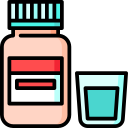
Opsomycetin
Form: Suspension
Strength: 125mg/5ml
Generic Name: Chloramphenicol
Company: Opsonin Pharma Limited
MRP:৳ 44.85 (60ml bot)
Is Antibiotic: No
Indications
Opsomycetin is an antibiotic used for serious infections caused by bacteria that can be treated with this drug. Opsomycetin is usually used when other less harmful antibiotics are not effective or not safe. However, Opsomycetin may be given to start treatment based on the doctor’s judgment. Sensitivity tests should be done to stop the use of this drug as soon as possible if other antibiotics are found to be more suitable for the infection.
Pharmacology
Opsomycetin works mainly by stopping the growth of bacteria. Opsomycetin is effective against a wide range of bacteria, including those that cause diseases like typhoid and influenza. Opsomycetin interferes with the bacteria’s ability to make proteins. The drug is absorbed quickly in the stomach and spreads throughout the body. Opsomycetin is mostly removed from the body through urine, and small amounts are also found in bile and feces. Opsomycetin can reach the brain and spinal fluid, but not in large amounts unless there is inflammation in the brain.
Dosage & Administration
Adults: The recommended dose is 50 mg/kg/day divided into 4 doses, given at 6-hour intervals. In special cases, higher doses may be needed. People with liver or kidney problems may need a lower dose.
Pediatric patients: The recommended dose for children is also 50 mg/kg/day, given in 4 doses every 6 hours. Severe infections may require a higher dose, but Opsomycetin should be reduced to 50 mg/kg/day as soon as possible.
Newborn infants: Newborns should receive 25 mg/kg/day, divided into 4 doses every 6 hours.
Interaction
Opsomycetin can interact with other medications like tolbutamide, phenytoin, and dicoumarol, and affect their breakdown in the body. Opsomycetin should be used carefully when combined with lincomycin, clindamycin, or erythromycin, as they may compete with Opsomycetin for binding sites. Rifampin can reduce its effectiveness.
Contraindications
Opsomycetin should not be used by anyone who is allergic to Opsomycetin or any of its ingredients. Opsomycetin is not for treating mild infections, such as colds or the flu, or to prevent bacterial infections when there is no clear need.
Side Effects
Not available at this time.
Pregnancy & Lactation
Not available at this time.
Precautions & Warnings
Opsomycetin is important to regularly check blood counts during treatment. Early signs of blood problems, like low white blood cells or platelets, should be monitored to avoid serious conditions like bone marrow failure.
Overdose Effects
An overdose can be toxic, causing serious blood problems like anemia, low platelets, and low white blood cells. Symptoms of overdose include nausea, vomiting, diarrhea, and high iron levels. If overdose occurs, treatment like charcoal hemoperfusion may help remove the drug from the body.
Therapeutic Class
Opsomycetin belongs to the macrolides class of antibiotics.
Storage Conditions
Store Opsomycetin in a cool, dry place. Keep the bottle tightly closed and protect Opsomycetin from light.